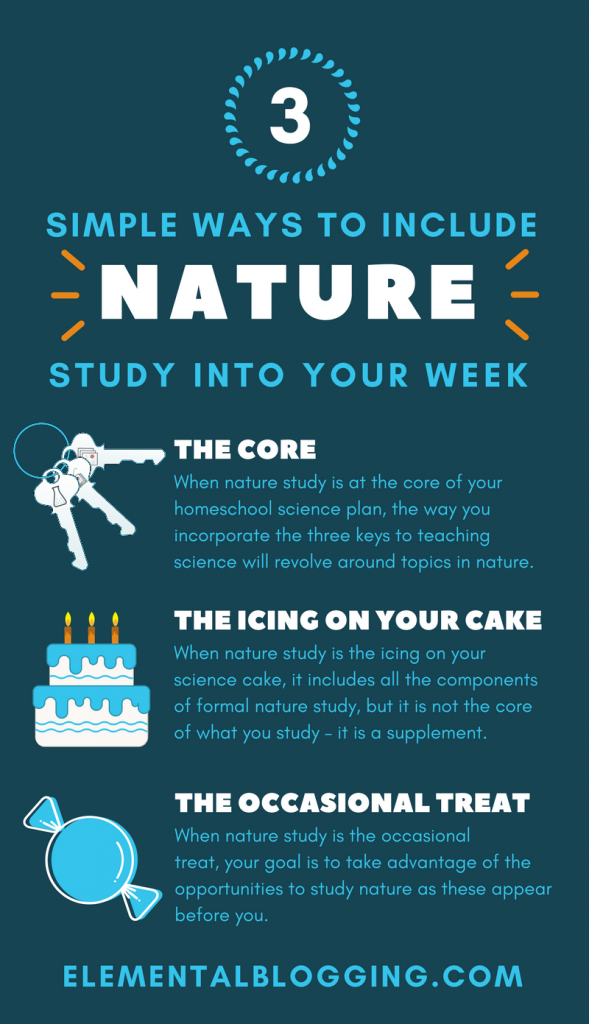 Now that you understand the differences between formal nature study and informal nature study. But a question still lingers – how do you include nature study into your week?
Now that you understand the differences between formal nature study and informal nature study. But a question still lingers – how do you include nature study into your week?
Is it the centerpiece?
Or just an afterthought?
By now, you know that I feel nature study is a beneficial way to learn about science. It can be an especially helpful tool when you are studying biology and earth science.
But, the true beauty of nature study is that it can awaken the scientific side of the brain in the same way that good book can awaken the imagination. There is so much our students can learn and appreciate from the natural world!
So, where should you include nature study in your homeschool science plan?
3 Simple ways to include nature study into your week
Simply put – nature study can be:
- the core of your homeschool science plan
- the icing on the cake
- or an occasional treat
Let’s take a closer look the options.
The Core of your Homeschool Science Plan
First off, it is possible to teach science without demonstrations or experiments. The way you can do this is with nature study.
When nature study is the core of your homeschool science plan, your week is led by finding science in the outdoors. You will do a formal nature study of a topic – complete with a nature walk and a nature journal page.
Then, you will enrich this time by reading about the topic you observed, using non-fiction books. If time and interest allow, you can add in an additional project or craft or some memory work.
Basically, when nature study is at the core of your homeschool science plan, the way you incorporate the three keys to teaching science will revolve around topics in nature.
But what if you want to do hands-on science in the lab and in nature?
Then, you will want to choose one of the next two options.
The Icing on your Science Cake
In our homeschool, we have something call “Friday Fun Days.” I am sure that I am not the first one to use that phrase, but I have no idea who was.
Anyways, when our daughter was younger, on Fridays we would do an art project, go to the library, and set aside some time for nature study. It was a great way to end the week on a high note.
For our nature study time, I would plan topics on nature study relating to what we were studying in science and research them before we headed out Friday morning. Then, we would add to our nature journals in the field or after we returned home.
As you can see, our Friday Fun Days included all the components of formal nature study, but it wasn’t the core of what we studied – it was a supplement.
In this way, nature study became the icing on our science cake.
But what do you do if you don’t want to plan out nature study, but you still want to add it?
The Occasional Treat
This is by far the simplest way to add informal nature study into your week. Basically, your goal is to take advantage of the opportunities to study nature as these appear before you.
So, as you are growing and tending to your own garden, you can informally discuss how plants grow from a seed. You can share about monocots and dicots. You can talk about what soil is made of and how that affects how well it holds water. You can talk about the invertebrates, like worms and beetles, you find in and near the soil.
The possibilities are endless, and the best thing about this is that you don’t have to plan out any of these opportunities. Rather, they will present themselves as you work in your garden or as you hike the trails or walk the dog or play outside or . . . well, you get my point – the possibilities are endless.
Wrapping it Up
Whether you chose to include nature study as the center of your plans or to enhance your current science curriculum with impromptu opportunities or Friday Fun Days, you can’t go wrong!
 Sign up below to receive weekly tips & tools for homeschool science and we'll send you a FREE copy of
Sign up below to receive weekly tips & tools for homeschool science and we'll send you a FREE copy of